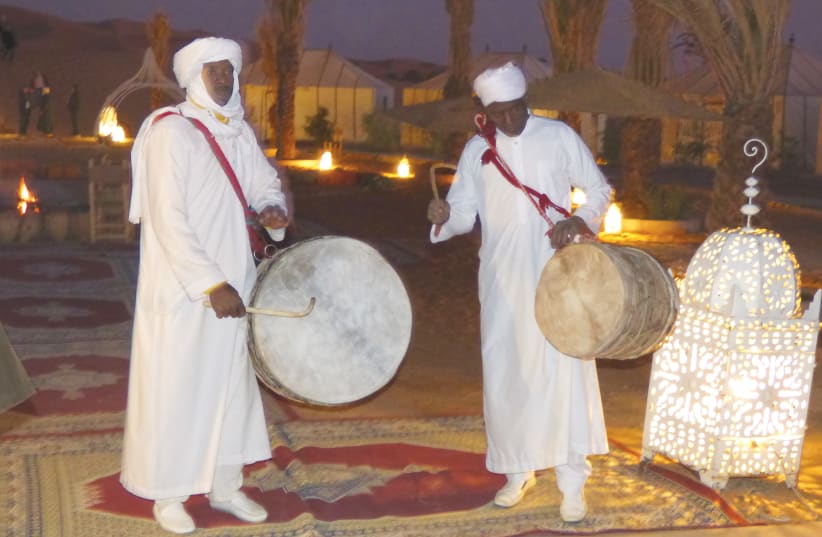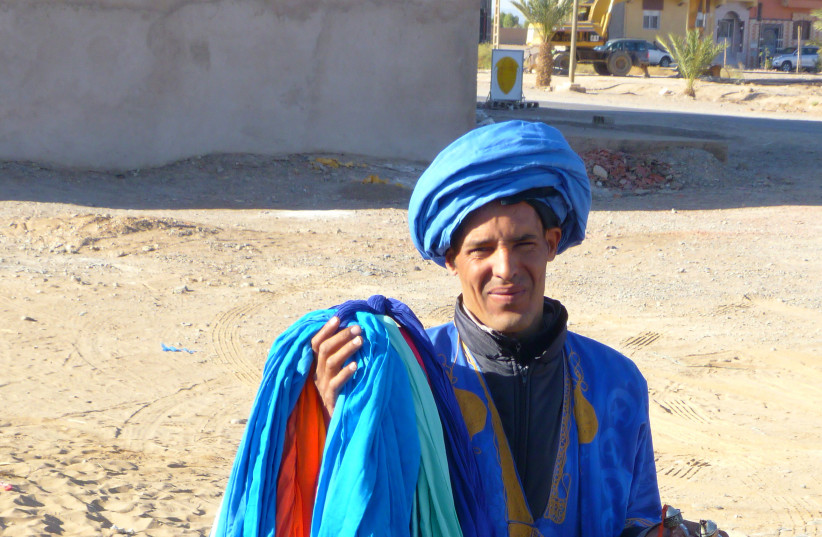The multi-colored patterned carpets displayed in Morocco’s souks mirror the countries cultural and religious palette – Imazighen, Jewish, Muslim, Christian – intricately blended into a tapestry of hues that reflect a history of incredible richness.
Today, there are only about 6,000 Jews in Morocco – mostly in Casablanca – but a large portion of Morocco’s population can trace their roots to Judaism with many still carrying names and wearing symbols rooted in Judaism.
The original peoples of Morocco were called Imazighen (singular: Amazigh) or Berber, which means “free men.” The Imazighen do not refer to themselves as Berber. To them it is a slightly derogatory term used by outsiders. Perhaps as long as 10,000 years ago, many Imazighen tribes settled in the Atlas Mountains while others migrated into the Sahara. Like many early semi-nomadic peoples, they were animists, worshiping nature spirits thought to exert power over their lives.
Their interaction with Jews came after the fall of Solomon’s Temple in 587 BCE, when Jews fleeing Jerusalem made their way to the Atlas Mountains seeking from the Babylonian onslaught. The Imazighen tribes were mainly herders and farmers, while the Jews were traders and craftspeople, sophisticated in the ways of the Silk Road caravans.
They brought with them goods and services, along with a religion, unknown to the Imazighen. Whether the Berbers, fascinated by the Jews, adopted the religious beliefs and rituals they saw being practiced, or the transplanted Jews assumed Berber customs, is unclear. But the two populations blended into a mutually harmonious community for hundreds of years, which eventually became known as Jewish Berbers.
In fact, in the Ameln Valley near Tafraoute, locals claim certain tribes are still referred to as Aït-Aouday (“Tribe of the Jews”), although the Jews are long gone.
The Jewish rebellion of 66 CE in the Holy Land saw the Diaspora soar into an avalanche of fleeing Jewish communities. Muslims arrived in the 7th and 8th centuries, and Muslims, Jews and Christians all lived together in segregated, but relatively peaceful, communities.
Marrakech’s Berber Museum is a good starting point to explore this ancient affiliation. On display are treasures from the diverse tribal regions that the Berbers occupied. I was mesmerized by the flamboyantly rich culture displayed in the collection. On exhibit are robes in varying colors and draping styles, head coverings in imaginative designs and breathtaking tribal jewelry that indicate status, tribal affiliation and provided security against hard times.
Many of the items are inscribed with Jewish stars and symbols, blending the religious beliefs of both groups into motifs that are meaningful only to the people who created them. The museum is housed in the workshop of French artist Jacques Majorelle (1886-1962) and was assembled by Pierre Bergé and Yves Saint-Laurent. www.jardinmajorelle.com
We spent a few days in stunning Marrakech before heading into the Atlas Mountains and the desert cities where Jewish Berbers thrived. We crossed the Middle Atlas Mountains and stopped at the ancient cedar forest of Ifrane National Park, near the town of Azrou, to see the Barbary macaques (tailless ground-dwelling old-world monkeys) entertaining the tourists. I watched as one little girl timidly held a piece of fruit out to a baby macaque. The animal, impatient for his treat, impishly reached out and grabbed the fruit out of her hand, settling the interaction on his terms and leaving the child whooping with joy.
The Atlas range separates the coastline from the Sahara, so in the distance we could spy sand dunes shimmering in the heat of the sun’s rays even though we were ankle-deep in last night’s snowfall.
We moved on to the desert village of Merzouga where we happened upon a settlement of the Gnawa clan, one of the Berber tribes still following the ancient nomadic lifestyle. We were warmly welcomed by the women and children but soon the children were shooed away while we sat down for tea on handwoven carpets covering the dirt floor and to watch the women weave the goods they were hoping to sell to us... and they did!
The highlight
The highlight of Merzouga for me was the camel ride in the desert. Two camels were linked together and led by Tuareg drivers wearing their ubiquitous blue turbans. The Tuareg tribe is known for its indigo head coverings; a scarf wrapped around the top of the head to keep the sun off and across the mouth to keep the sand out. In the days before suntan lotion, indigo was mined and ground into a powder to wear over exposed skin to protect against the harsh Sahara sun. Later the cooling effects of indigo were used as a dye, and to this day you can distinguish a Tuareg tribesperson by the beautiful blue clothing.
Getting on and off a camel is a challenge but the drivers were up to it and so good-humored they soon had us laughing as the camels launched from the sitting into the standing position. The drivers ran alongside us taking pictures of us as we “Lawrenced of Arabia” over the dunes. Just before the sun set, we slid off the camels and negotiated our way to the top of a sand dune to enjoy the ever-shifting shades the light from the setting sun cast over the dunes.
Sliding back down to the camels that were patiently waiting for our return, we remounted and continued to make our way to the tent complex set out just below the dunes. Welcoming us into the Sahara Desert Luxury Camp was a group of Berber entertainers singing and drumming around a large bonfire that lit up the now pitch black sky.
During our sojourn, we visited many synagogues, functioning or not, monuments to the Jewish presence in Morocco for thousands of years; cemeteries respectfully maintained with names familiar to all Jews; mellahs (Jewish quarters) with Hebrew inscriptions still carved on walls and over doors; and a population saddened over the loss of their Jewish compatriots.
From 1946 onward, there was an exodus of the Jewish population out of Morocco. By the time Morocco secured its independence from France in 1956, and after the Six Day War, many Jews, unsure of their safety living in an Islamic state, immigrated to Israel, France, Canada or the US, leaving their Moroccan homeland bereft of a significant portion of its identity.
By 1967 the leak was a flood and more than 300,000 Jews had departed, leaving a mere 6,000 remaining. Many Moroccans, then and now, mourn the loss of the Jewish population and accept the fact that they will not return to live... but hopefully they will come to visit.
For information: Visit the Moroccan National Tourist Board www.visitmorocco.com

